Microsoft AI-900 Exam Practice Questions (P. 2)
- Full Access (246 questions)
- One Year of Premium Access
- Access to one million comments
- Seamless ChatGPT Integration
- Ability to download PDF files
- Anki Flashcard files for revision
- No Captcha & No AdSense
- Advanced Exam Configuration
Question #6
HOTSPOT -
To complete the sentence, select the appropriate option in the answer area.
Hot Area:
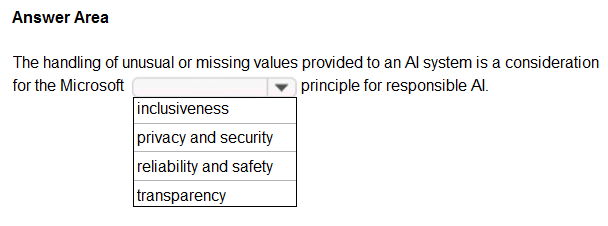
To complete the sentence, select the appropriate option in the answer area.
Hot Area:

Correct Answer:
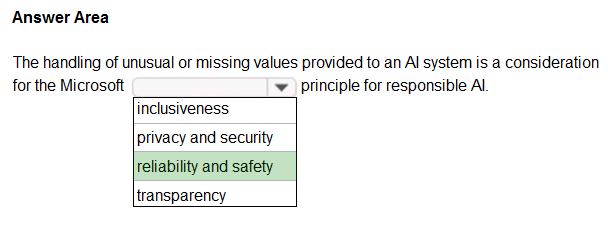
Reliability and safety:
AI systems need to be reliable and safe in order to be trusted. It is important for a system to perform as it was originally designed and for it to respond safely to new situations. Its inherent resilience should resist intended or unintended manipulation. Rigorous testing and validation should be established for operating conditions to ensure that the system responds safely to edge cases, and A/B testing and champion/challenger methods should be integrated into the evaluation process.
An AI system's performance can degrade over time, so a robust monitoring and model tracking process needs to be established to reactively and proactively measure the model's performance and retrain it, as necessary, to modernize it.
Reference:
https://docs.microsoft.com/en-us/azure/cloud-adoption-framework/innovate/best-practices/trusted-ai

Reliability and safety:
AI systems need to be reliable and safe in order to be trusted. It is important for a system to perform as it was originally designed and for it to respond safely to new situations. Its inherent resilience should resist intended or unintended manipulation. Rigorous testing and validation should be established for operating conditions to ensure that the system responds safely to edge cases, and A/B testing and champion/challenger methods should be integrated into the evaluation process.
An AI system's performance can degrade over time, so a robust monitoring and model tracking process needs to be established to reactively and proactively measure the model's performance and retrain it, as necessary, to modernize it.
Reference:
https://docs.microsoft.com/en-us/azure/cloud-adoption-framework/innovate/best-practices/trusted-ai
send
light_mode
delete
Question #7
DRAG DROP -
Match the types of AI workloads to the appropriate scenarios.
To answer, drag the appropriate workload type from the column on the left to its scenario on the right. Each workload type may be used once, more than once, or not at all.
NOTE: Each correct selection is worth one point.
Select and Place:
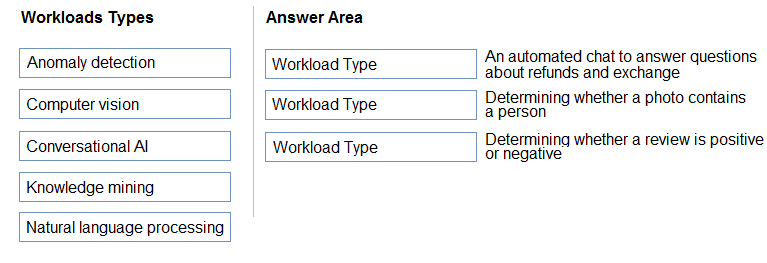
Match the types of AI workloads to the appropriate scenarios.
To answer, drag the appropriate workload type from the column on the left to its scenario on the right. Each workload type may be used once, more than once, or not at all.
NOTE: Each correct selection is worth one point.
Select and Place:

Correct Answer:
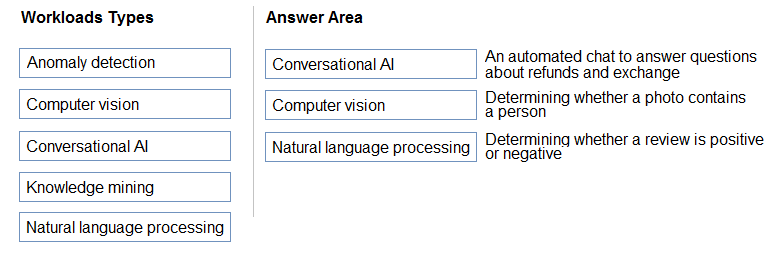
Box 3: Natural language processing
Natural language processing (NLP) is used for tasks such as sentiment analysis, topic detection, language detection, key phrase extraction, and document categorization.
Reference:
https://docs.microsoft.com/en-us/azure/architecture/data-guide/technology-choices/natural-language-processing

Box 3: Natural language processing
Natural language processing (NLP) is used for tasks such as sentiment analysis, topic detection, language detection, key phrase extraction, and document categorization.
Reference:
https://docs.microsoft.com/en-us/azure/architecture/data-guide/technology-choices/natural-language-processing
send
light_mode
delete
Question #8
You are designing an AI system that empowers everyone, including people who have hearing, visual, and other impairments.
This is an example of which Microsoft guiding principle for responsible AI?
This is an example of which Microsoft guiding principle for responsible AI?
- Afairness
- BinclusivenessMost Voted
- Creliability and safety
- Daccountability
Correct Answer:
B
Inclusiveness: At Microsoft, we firmly believe everyone should benefit from intelligent technology, meaning it must incorporate and address a broad range of human needs and experiences. For the 1 billion people with disabilities around the world, AI technologies can be a game-changer.
Reference:
https://docs.microsoft.com/en-us/learn/modules/responsible-ai-principles/4-guiding-principles
B
Inclusiveness: At Microsoft, we firmly believe everyone should benefit from intelligent technology, meaning it must incorporate and address a broad range of human needs and experiences. For the 1 billion people with disabilities around the world, AI technologies can be a game-changer.
Reference:
https://docs.microsoft.com/en-us/learn/modules/responsible-ai-principles/4-guiding-principles
send
light_mode
delete
Question #9
DRAG DROP -
Match the Microsoft guiding principles for responsible AI to the appropriate descriptions.
To answer, drag the appropriate principle from the column on the left to its description on the right. Each principle may be used once, more than once, or not at all.
NOTE: Each correct selection is worth one point.
Select and Place:
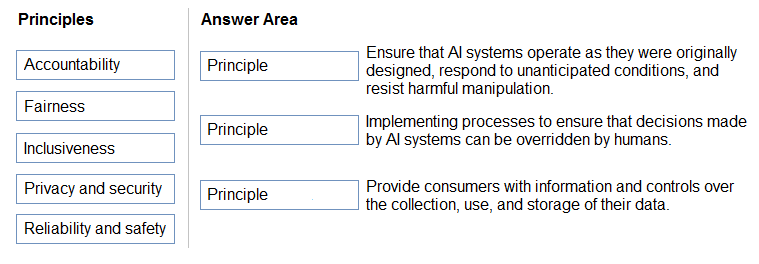
Match the Microsoft guiding principles for responsible AI to the appropriate descriptions.
To answer, drag the appropriate principle from the column on the left to its description on the right. Each principle may be used once, more than once, or not at all.
NOTE: Each correct selection is worth one point.
Select and Place:

Correct Answer:
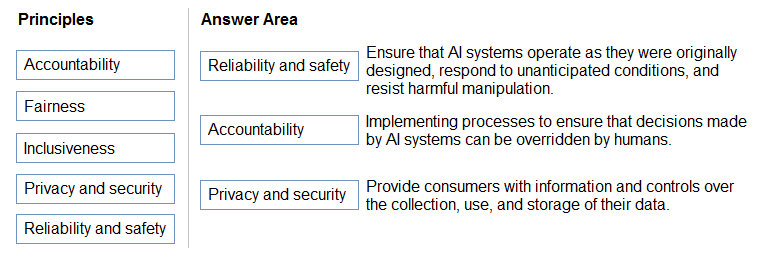
Box 1: Reliability and safety -
To build trust, it's critical that AI systems operate reliably, safely, and consistently under normal circumstances and in unexpected conditions. These systems should be able to operate as they were originally designed, respond safely to unanticipated conditions, and resist harmful manipulation.
Box 2: Accountability -
The people who design and deploy AI systems must be accountable for how their systems operate. Organizations should draw upon industry standards to develop accountability norms. These norms can ensure that AI systems are not the final authority on any decision that impacts people's lives and that humans maintain meaningful control over otherwise highly autonomous AI systems.
Box 3: Privacy and security -
As AI becomes more prevalent, protecting privacy and securing important personal and business information is becoming more critical and complex. With AI, privacy and data security issues require especially close attention because access to data is essential for AI systems to make accurate and informed predictions and decisions about people. AI systems must comply with privacy laws that require transparency about the collection, use, and storage of data and mandate that consumers have appropriate controls to choose how their data is used
Reference:
https://docs.microsoft.com/en-us/learn/modules/responsible-ai-principles/4-guiding-principles

Box 1: Reliability and safety -
To build trust, it's critical that AI systems operate reliably, safely, and consistently under normal circumstances and in unexpected conditions. These systems should be able to operate as they were originally designed, respond safely to unanticipated conditions, and resist harmful manipulation.
Box 2: Accountability -
The people who design and deploy AI systems must be accountable for how their systems operate. Organizations should draw upon industry standards to develop accountability norms. These norms can ensure that AI systems are not the final authority on any decision that impacts people's lives and that humans maintain meaningful control over otherwise highly autonomous AI systems.
Box 3: Privacy and security -
As AI becomes more prevalent, protecting privacy and securing important personal and business information is becoming more critical and complex. With AI, privacy and data security issues require especially close attention because access to data is essential for AI systems to make accurate and informed predictions and decisions about people. AI systems must comply with privacy laws that require transparency about the collection, use, and storage of data and mandate that consumers have appropriate controls to choose how their data is used
Reference:
https://docs.microsoft.com/en-us/learn/modules/responsible-ai-principles/4-guiding-principles
send
light_mode
delete
Question #10
HOTSPOT -
To complete the sentence, select the appropriate option in the answer area.
Hot Area:

To complete the sentence, select the appropriate option in the answer area.
Hot Area:

Correct Answer:

Reliability and safety: To build trust, it's critical that AI systems operate reliably, safely, and consistently under normal circumstances and in unexpected conditions.
These systems should be able to operate as they were originally designed, respond safely to unanticipated conditions, and resist harmful manipulation.
Reference:
https://docs.microsoft.com/en-us/learn/modules/responsible-ai-principles/4-guiding-principles

Reliability and safety: To build trust, it's critical that AI systems operate reliably, safely, and consistently under normal circumstances and in unexpected conditions.
These systems should be able to operate as they were originally designed, respond safely to unanticipated conditions, and resist harmful manipulation.
Reference:
https://docs.microsoft.com/en-us/learn/modules/responsible-ai-principles/4-guiding-principles
send
light_mode
delete
All Pages
